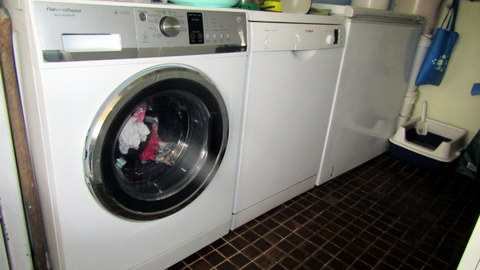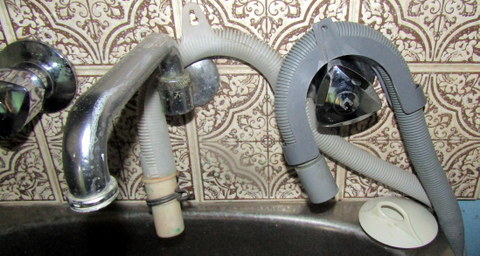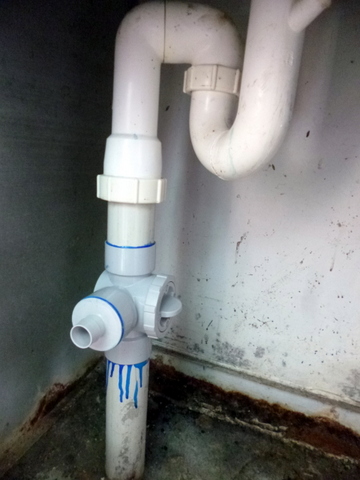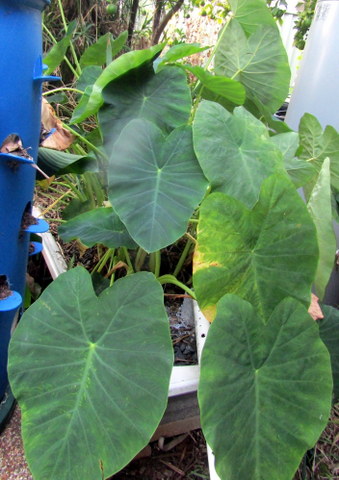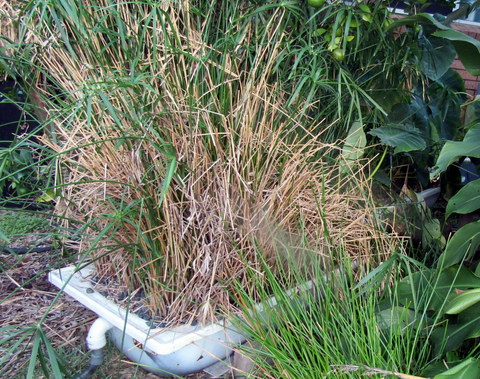As mentioned in the article on the sustainable kitchen, the laundry does take some overflow from the kitchen in terms of functionality. It is not a big room but currently stores our bulk food in 20 litre buckets, has the bag our recyclables go in hanging from the wall and it is also where the dishwasher is located. But we have also managed to fit in some other stuff too into its 1800mm x 3000mm innards!
1. The Freezer – while this was originally bought in to preserve the meat supply, these days we use it to hold other stuff. It is a chest freezer, and while it is not as easy to keep track of what is in a chest freezer they are more efficient because you don’t get all the cold air falling out like you do as soon as you open the door of an upright freezer.
We find it very handy for holding stuff like bulk rolled oats, it not only keeps them fresh and extends their shelf life so we can buy a 25kg bag and work off that but it also prevents the whole bag going solid with pantry moth webs and grubs during the warmer months. I hate pantry moth! We also cook up several kilos at a time of legumes like red kidney beans, black turtle beans and chick peas, then freeze them in 250gm to 300gm portions which is roughly equivalent to a drained can. We can then just thaw and use them without having a stack of cans to recycle!
We also use it for bread, rolls etc, whether we make them or buy them. If left in the bread keeper until we use them, they will inevitably just go fungus, especially in the warmer months and I hate the taste of penicillin! Freezing the bread means we eat it all, but the composter and the chooks miss out.
2. The dishwasher – this obviously is a carryover from the kitchen, but it resides in the laundry room and as I mentioned in the kitchen article “With there being only the two of us, it takes time to make up a load for the dishwasher, but it is much more water efficient to do that rather than do a series of small hand washes every day. The dishwasher (a Bosch) uses about 10 litres per load on our usual setting, which equates to 3 – 4 hand washes whereas each hand washed load we do would probably consume 15 litres by itself. The extra energy consumed is not an issue due to the solar energy/battery system providing the electricity for free.”
While it wouldn’t fit in the kitchen anyway, one plus of having it in the laundry is that it can be included in the laundry greywater system which I will cover in the discussion about the washing machine. While it is possible to treat the greywater coming out of the dishwasher through the system, it currently isn’t because I am concerned that the alkalinity of the dishwasher greywater may be a bit high for it to cope with. I am researching homemade alternatives under the caveats from my sweetie that anything I come up with –
a. must effectively clean the dishes etc, and
b. must not bugger the dishwasher!
The search continues!
3. Washing machine – We used to have a top loading washing machine, and I just used a hose of the required diameter connected to the end of the washing machine waste water outlet to run the greywater out onto the lawn. However, as we all know, front loaders are more water efficient, so that when it came time for the top loader to meet its maker (or the metal recycler) we bought a front loader. This was not without its own issues, however, as we were putting in the same clothes and washing detergent, but it was using less water – therefore the concentration of pollutants would be higher! QED!
So, rather than run the greywater from the new machine out onto the lawn directly, I built a constructed wetland to treat it first, the full story on it can be found here. The water exits the hose from the machine into the laundry tub as a holding tank, and from there is moves slowly via a flexible hose into the constructed wetland. It has certainly cleaned up the greywater from the washing machine, even dropping the pH down from 9.6 to 7.4, so it was able to be run onto the ground under some citrus trees. This proved to be very handy during our recent drought.
The Other stuff - There is not much else in the laundry (there is not much room) but there is a cupboard which holds laundry stuff, soapmaking stuff, catfood stocks, some of our preserves empty preserving jars as well as other miscellaneous bits and pieces.
The Room Itself – Along with the rest of the house, the electricity supply for the laundry is generated by our collection of solar panels and stored in batteries and supplied though the inverter and the lighting is 12 volt, supplied directly from the batteries. When the weather gets hot, a door snake goes to block off the area under the door to keep the western sun out, the polystyrene foam window shield is installed, and we shut off the laundry from the rest of the house with a blanket across the doorway. We used to have a door there but it kept getting in the way so I took it off.
One thing I want to investigate in the future, in the roof above the laundry is the old unused 300 litre hot water tank and I want to talk to a plumber about running a pipe to the laundry sink from it, and having some way of filling it with tank water. I could then use rainwater for some laundry operations. I suspect it might be expensive though.
Other parts of our Zone 0



